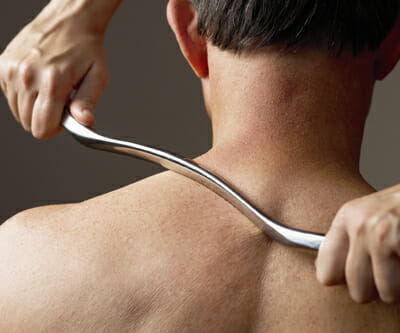A patient named Jaymes came in to see us at Dynamic Sports Physical Therapy due to some debilitating shoulder issues. Jaymes had been experiencing pain, stiffness, and a clicking sensation in both of his shoulders, which was interfering with his ability to stand, reach, and carry photography equipment at his job. He also noted that he was limited when trying to reach overhead or across his body, and he often felt a weakness in his arms from fatigue after long days of photo shoots.
The first step in the treatment process for Jaymes was a full-scale evaluation of his mid-to-upper spine, as well as the muscles surrounding the shoulder. Results showed that Jaymes had severely limited flexibility when rotating this region of the spine, as well as limitations when moving his shoulders in a number of directions. Additional findings from Jaymes’ evaluation included the following:
- Increased sensitivity, pain, and stiffness in the mid-to-upper spine and the shoulder joints
- Significant muscular restrictions throughout neck, upper back, shoulders, chest wall, and hips
- A decreased ability to dissociate scapulothoracic movements of the shoulders
- Severe kyphotic posture when standing and sitting, which caused Jaymes to hunch his back
- Inefficient breathing with a lot of breath-holding while lifting, bending, and squatting maneuvers
- Poor strength in a number of the muscles of the upper back and shoulders
Based on this evaluation, Jaymes was diagnosed with a condition called T4 syndrome, which is also known as upper thoracic syndrome.
What we did at Dynamic Sports Physical Therapy in New York City to help Jaymes improve
Before beginning treatment, Jaymes stated that his goals were to reduce his pain levels, improve his posture, and regain flexibility throughout his upper body. He also wanted to improve his general fitness and flexibility habits in the long term.
The first part of treatment consisted of manual therapy that followed an impairment-based approach. The sessions would start with manual therapy and then slowly progress into postural training, followed by exercises for the home and long term maintenance. Each session would include some combination of the following techniques:
- Joint manipulation and mobilization of the mid-to-upper spine
- Soft-tissue massage
- Taping techniques to improve posture
- Electrotherapy, ultrasound, or laser therapy
- Cupping and the Graston Technique
- Training in standing, lifting, and carrying ergonomics
- Postural restoration and integration techniques
- Stretching and strengthening exercises of the neck, shoulder, and upper back
- Exercises for flexibility and stabilization of the core muscles throughout spine
After 6-8 weeks of physical therapy, Jaymes noted that he experienced a decrease in flare-ups of his back and shoulder pain. He reported feeling stronger at work with improved stamina and posture. Although his left shoulder still clicks occasionally, there is no pain, and he is able to reach further overhead and across/away from his body during daily activities—something he recalled never being able to do very well.
Jaymes had this to say about his outcome after therapy: “It feels strange to slouch like I used to—almost as if my body is unable to be hunched over like that anymore. I didn’t realize how much more I can and am supposed to reach overhead—my arm is going new places!”
Jaymes’ story is a testament to how physical therapy can help patients achieve their full potential, which in some cases, they might not even be aware of. We are thrilled to see how pleased Jaymes is with his treatment, and wish him continued success. If you’re experiencing any issues of your own that are holding you back, Dynamic Sports Physical Therapy in New York City would like to help you next. Contact us at 212-317-8303 to schedule an appointment today, or click here to read our last blog more information on T4 syndrome.

